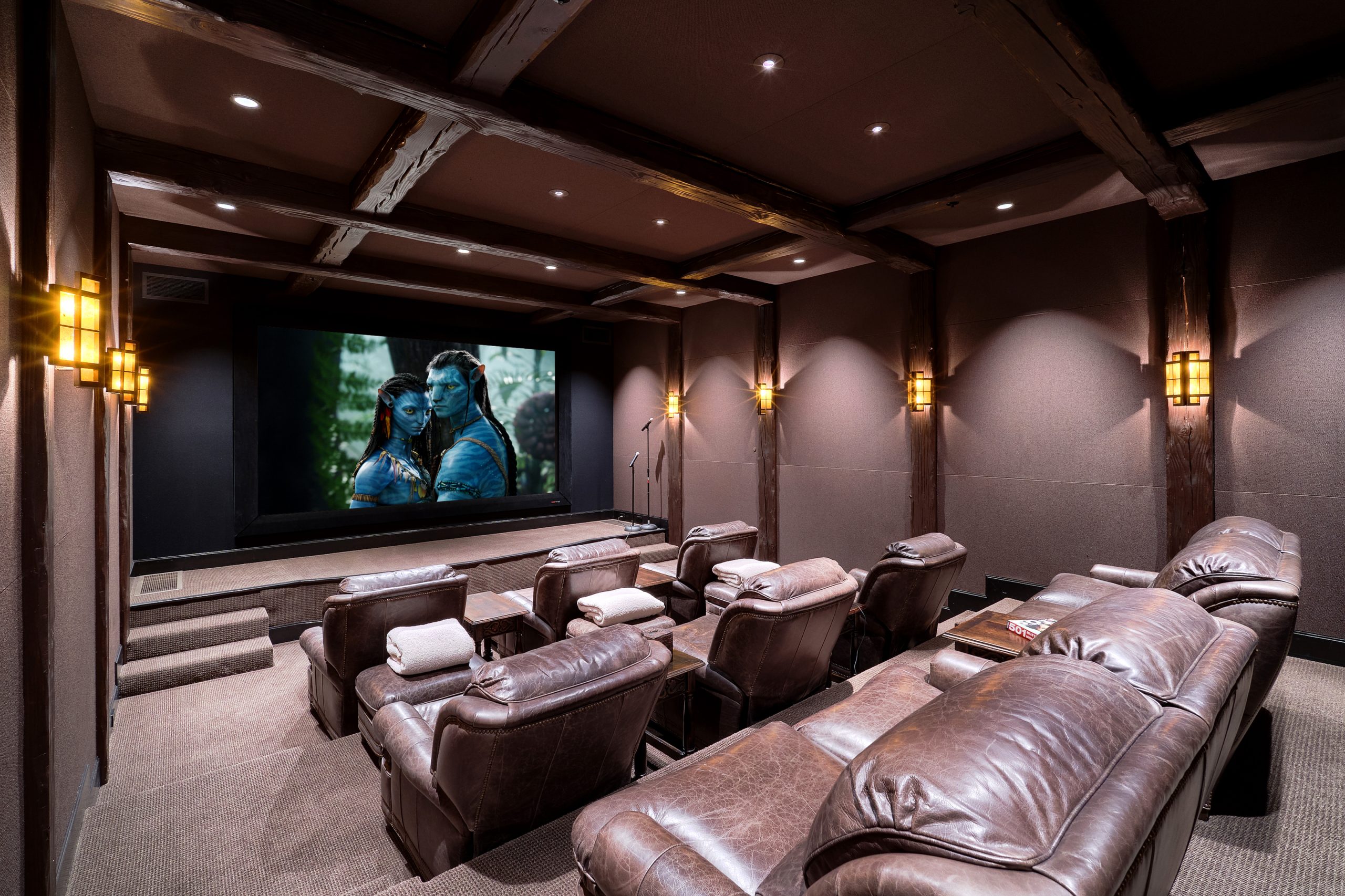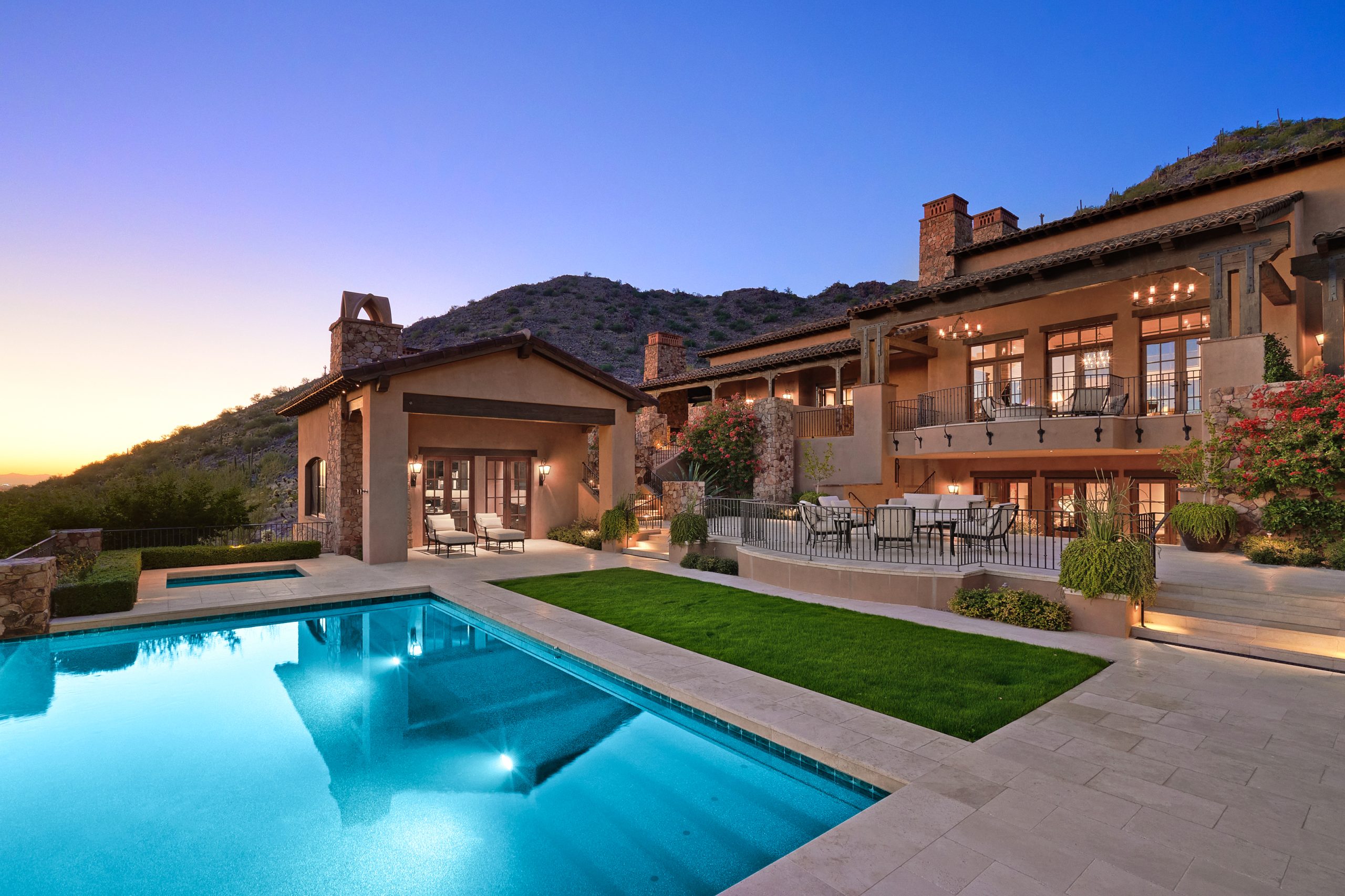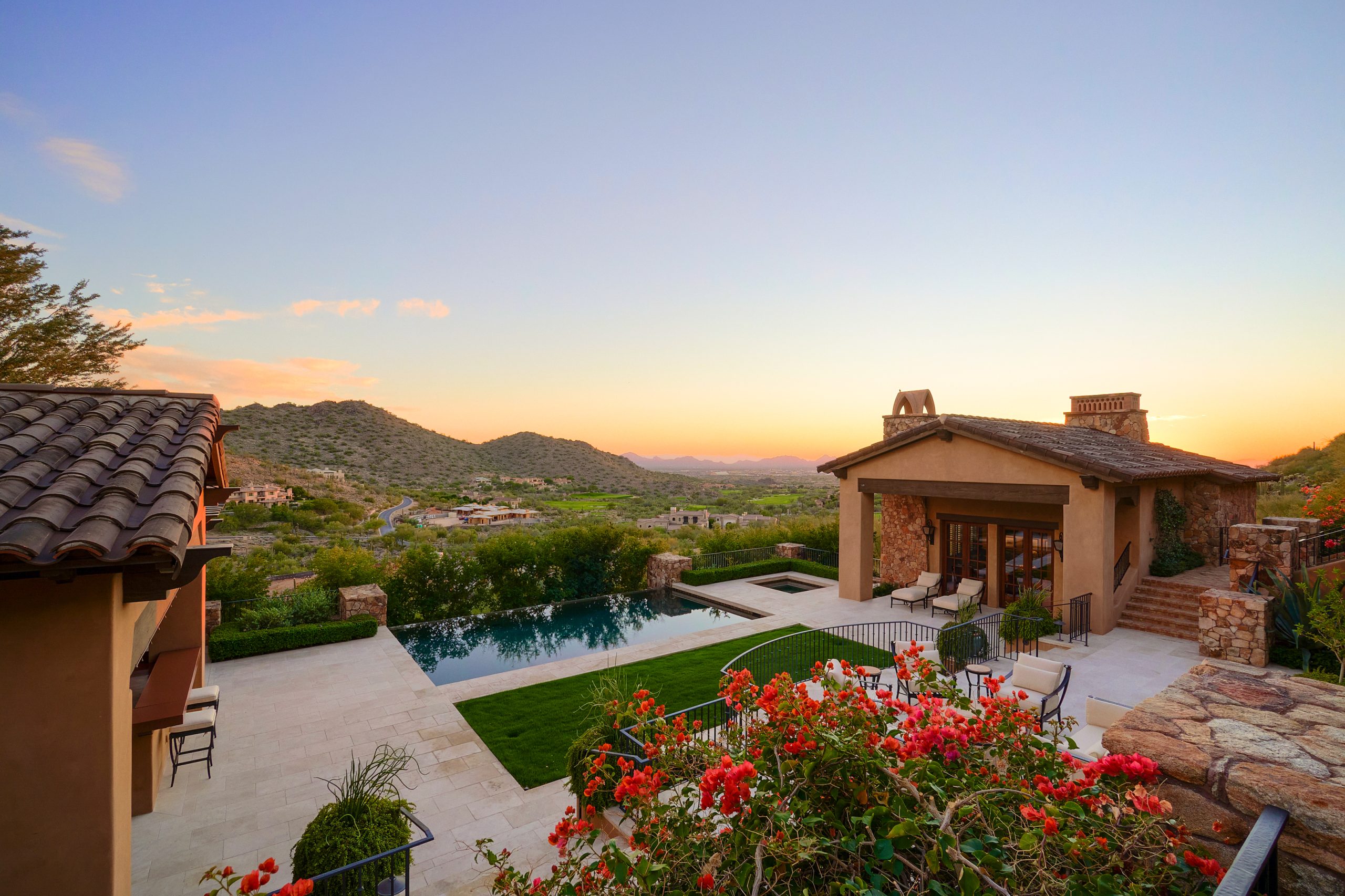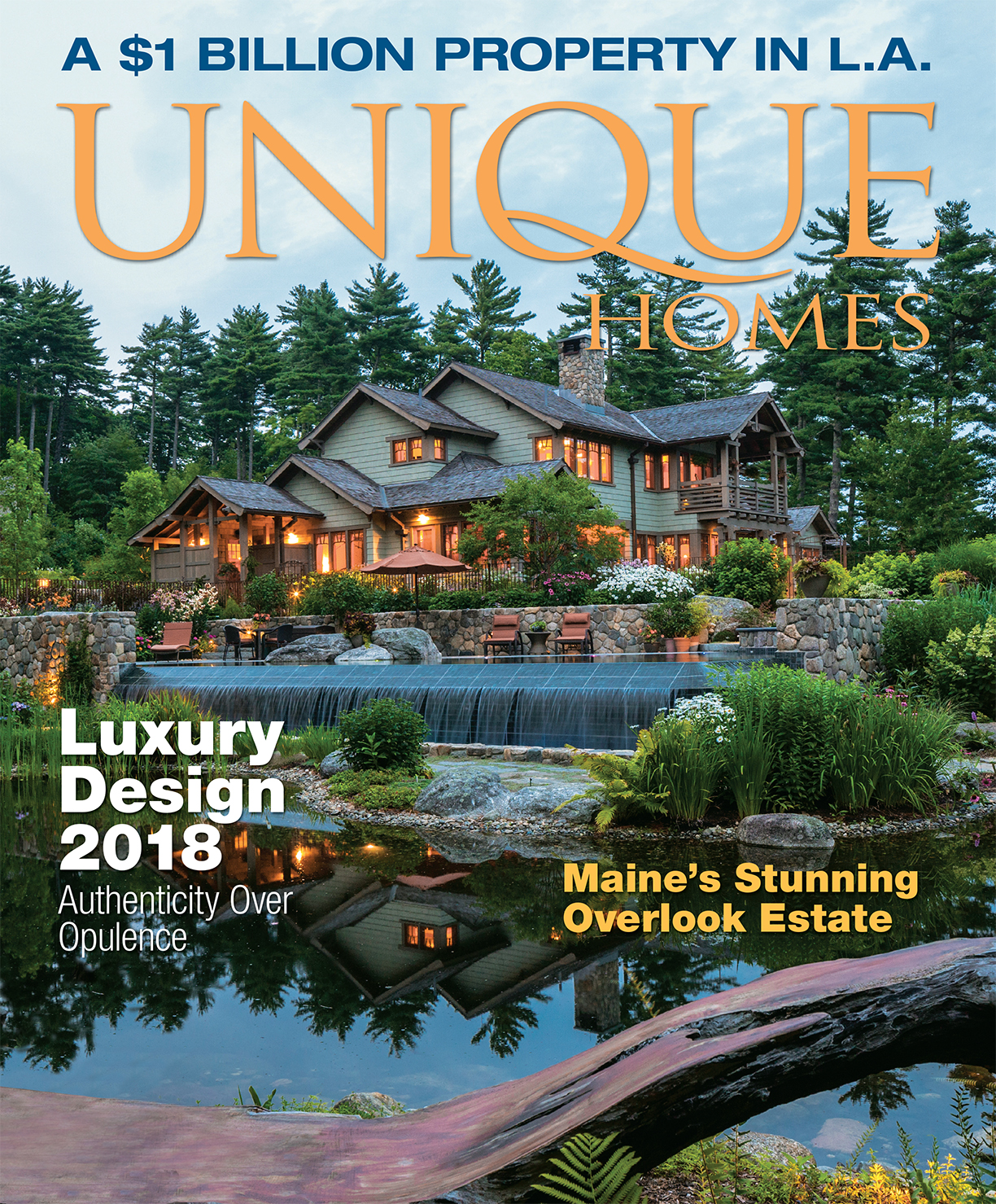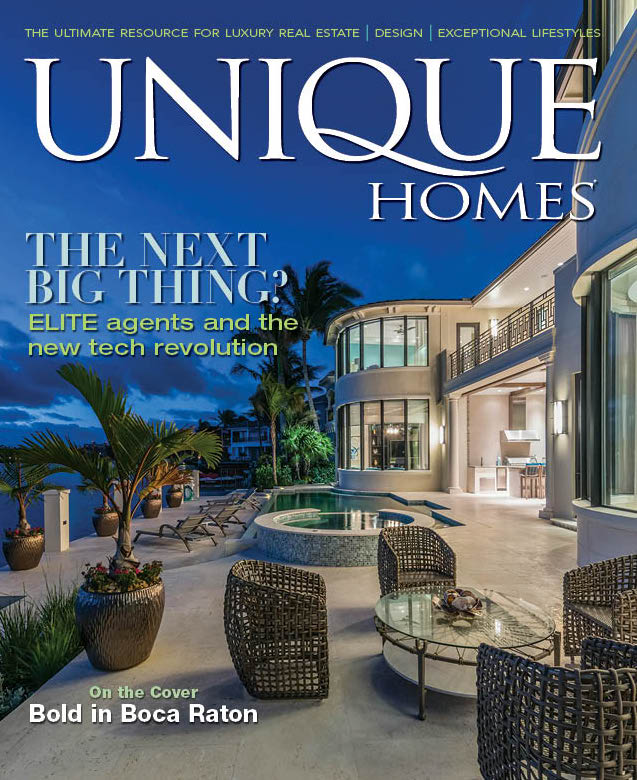This estate is a beautiful expression of ranch hacienda-style architecture. Designed by acclaimed architect John Sather of Swaback Partners, it was built with the highest quality materials and workmanship, and every room reflects extraordinary attention to detail. Nestled on six acres on the side of the McDowell Mountains – and backing onto a nature preserve – the property is truly a mountainside sanctuary that offers both privacy and an organic connection to the Sonoran Desert.
The entrance speaks volumes about what’s inside. The imposing arched front door with seeded-glass panels was custom crafted of reclaimed materials by La Puerta of Santa Fe, and the two-story entryway features a commanding chandelier fabricated by the trade-only designer Paul Ferrante. The hardwood floors in the house are made of distressed hickory, and they perfectly compliment the artisanal plasterwork on the walls. Imported from Italy, the Albertini windows and glass-paneled doors, with their rich burnt-pine finish, are another strong design element. Tucson-based Taber & Co. made the bespoke in-wall mesquite cabinets in the living room, and the custom interior doors are also solid mesquite.
Attention to detail is found throughout. The twin custom granite sinks in the kitchen feature integrated drain boards chiseled into the countertop – no dish racks needed. To reduce back strain when rolling dough, chopping vegetables, or doing other prep work, the center island was set at an above-standard 42” height. Electric outlets throughout the house were faux painted to match the surrounding walls and backsplashes. The three decorative panels on each interior door were deliberately sized so that the door lever is perfectly centered on the door rail. And the massive living room fireplace surround was entirely assembled from book-matched marble slabs, to stunning effect.
Many of the rooms are worthy of special mention. Befitting a movie producer who wants to experience films in the best possible way, the 10-seat tiered theater is equipped with state-of-the-art projection and sound systems designed by Shen Milsom & Wilke, a world-class engineering firm. Next to the theater on the lower level is a 2,000-bottle wine cellar, whose rustic stone walls help maintain ideal temperature and humidity levels for long-term storage. Also on the “play” level is a game room that can accommodate all sorts of toys, which currently include a pool table, juke box, Skee-Ball alley, Harley-themed pinball machine and poker table.
The spacious Primary Suite was designed to achieve just the right balance between privacy and togetherness. The suite has a common bedroom but completely separate dual bathrooms and dual closets. The suite also includes a room for luggage storage and a private patio with a fireplace and whirlpool.
Located in a stand-alone structure a little further up the mountain, the Spa is another noteworthy space. On one side is a fully equipped exercise room with wall-to-wall French doors and transom windows that wash the room with light and offer lovely views of a desert garden. On the other side is an intimate massage room with an exquisite domed mosaic ceiling.
How many homes have an ADA-compliant bedroom suite? This one does. All of the light switches are set at ADA height, the bathroom vanity is ADA accessible, and there are grab bars at the commode and in the shower. A commercial-grade elevator serves all three floors and is also ADA-compliant.
The exterior spaces are equally impressive. Berghoff Design Group did the landscaping, which features a virtual arboretum of mature, thriving ironwood, palo verde, mesquite, and Texas ebony trees, all native to the Desert Southwest. These trees form a natural canopy and add to the overall sense of privacy which characterizes this property. The fountains are genuine antiques, and an inviting bougainvillea-lined walkway made from reclaimed stone leads to the main entrance.
Coming Soon on MLS info:
https://www.flexmls.com/link.html?1o78de5c3cx6,12,1
Video: https://vimeo.com/648347361
Property Website
Culdesac will be the first neighborhood-scale community with zero residential parking, which will allow for more open spaces that can be used for socializing, events, and getting to know your neighbors.
Rendering by Opticos Design.
A five-minute city, car-free and golf cart centered communities are gaining momentum around the United States, from Port Aransas, Texas, to Tempe, Arizona.
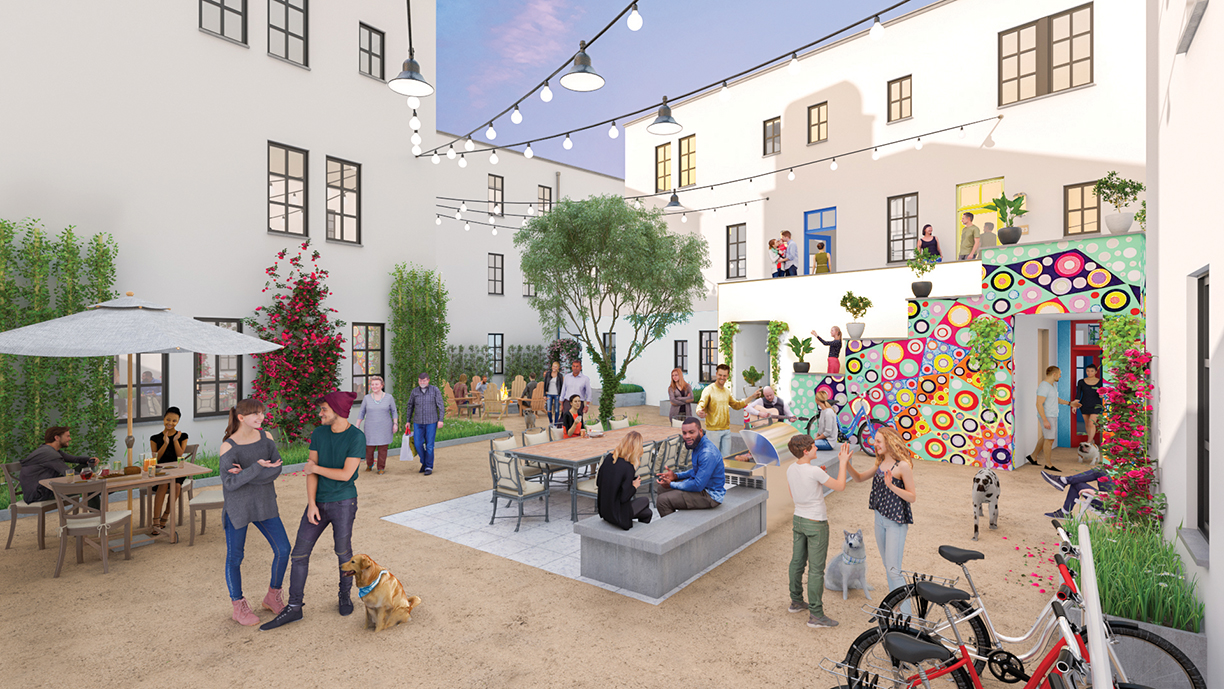
With plenty of extra outdoor space, Culdesac will hold over 150 events per year, including concerts, food trucks on the plaza, outdoor yoga classes, and more that guests can enjoy close to home.
Rendering by Opticos Design.
Automobiles have long been a symbol of freedom and advancement, making it easy to overlook the strain they put on our communities and the environment. Even smaller cities are battling noise and air pollution as the number of cars per household increases. Long commutes, congested traffic routes, parking fees, and pollution have all encouraged a whole new way of thinking when it comes to cars.
Culdesac, in Tempe, Arizona is the first car-free community in the United States that has been built from top to bottom around the idea that cities can be made better. “The vision has always remained the same — to build cities for people and not cars,” says Culdesac’s general manager, Lavanya Sunder. Space that is typically reserved for roads, parking lots, and individual parking has been completely rethought in this rental apartment community. Parking lots and garages have been replaced with wide-open spaces that offer everything from fire pits and hammocks to water features and inviting courtyards.
Tempe, Arizona, offered the ideal canvas for a project like Culdesac. “We chose Tempe for its thriving job market, proximity to transportation, and forward-thinking, action-oriented local government,” says Sunder. These are among the added benefits when considering a car-free community.
“By removing parking lots, we were able to see all of the possibilities, twice the retail, triple the open space, and 55-percent landscape coverage, compared to less than 20 percent from comparable developments,” notes Sunder.
The community was designed as a five-minute city, meaning everything residents might need is within reach and life is at your front door. “Homes at Culdesac all open up to vibrant shared courtyards, versus impersonal hallways in traditional apartment complexes,” says Sunder. Seemingly small details such as this contribute to the overall atmosphere that is created when a place urges its residents to slow down. “Community is a key component of Culdesac. Culdesac will have over 150 events per year, including concerts, food trucks on the plaza, outdoor yoga classes, and more.”
Communities such as Culdesac are finding that residents are drawn to the idea of knowing their neighbors again. A notion that hasn’t been overlooked in other communities around the United States. Port Aransas, Texas, is a beautiful beach destination that is like traveling back in time. The eclectic atmosphere is entirely accessible by golf carts, including the 18 miles of beach, with spacious boardwalks that accommodate the carts and encourage foot traffic. The use of golf carts decreases traffic, noise and pollution, and creates a very relaxed pace around the island. Cinnamon Shore, the 1,000-acre, master-planned beachfront community is very walkable and designed with families in mind who want to enjoy the small-town feel in Port Aransas.
A private luxury community, Haig Point, on the northern end of Daufuskie Island in South Carolina is only accessible by ferry, and the island is almost entirely car-free. Residents and guests never have to worry about traffic, stopping for gas, or finding a parking space, as the island runs mainly on golf carts. Similarly, Fire Island, across the Great South Bay from Long Island, New York, is another popular summer retreat that functions smoothly without cars. Bikes, golf carts, and jet skis are the best way to experience the Fire Island’s top-tier accommodations.
According to the Bureau of Transportation Statistics, “the mean number of vehicles in households is 1.9 personal vehicles…. Thus, it appears that households on average have more vehicles than drivers.” American cities, from New York to San Francisco, are struggling to provide enough space to merely park all of these vehicles, nevermind drive them.
Our personal space, green space, shared space, and even sidewalks have decreased significantly over the years as the need to accommodate a growing number of automobiles increases.
Communities such as Culdesac are hoping it is time for the urban form to be rethought and upgraded. “We also will have an “Extend Your Home On-Demand” Program,” says Sunder.
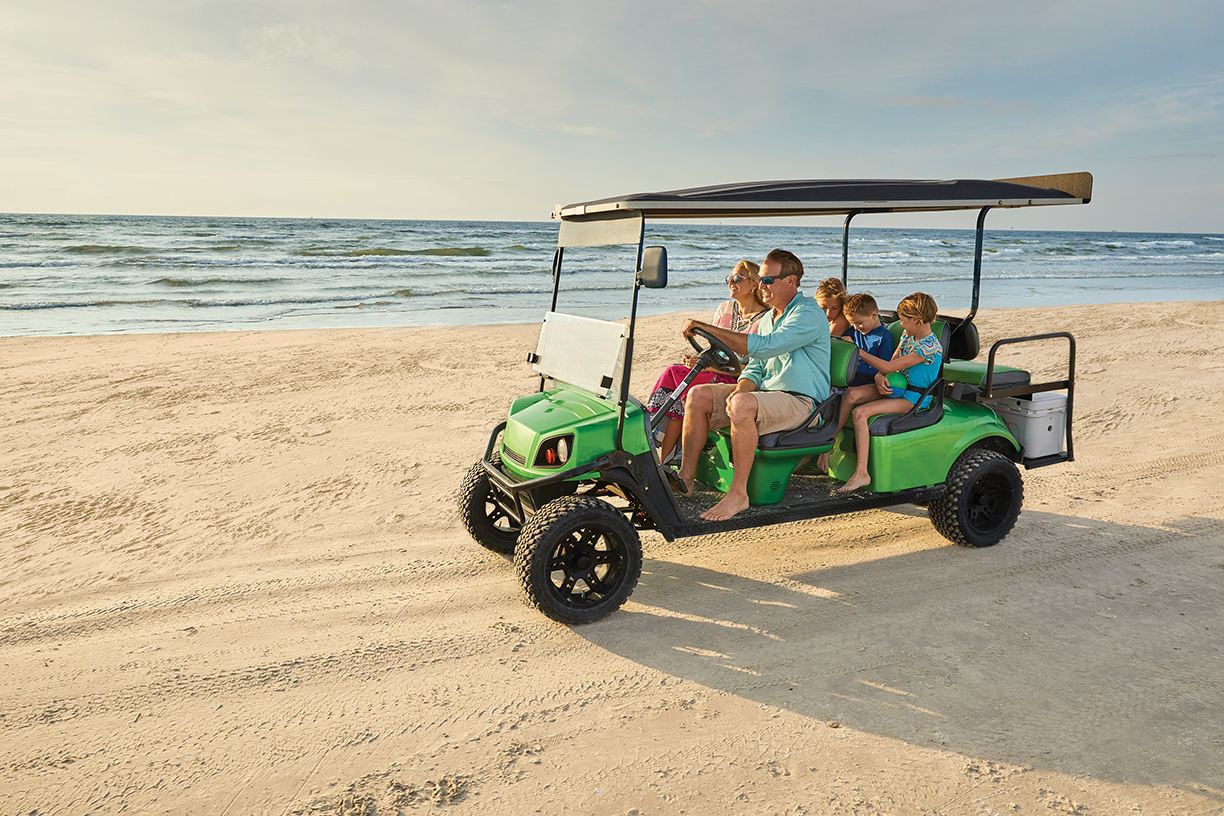
Communities such as Cinnamon Shore in Port Aransas, Texas, are embracing the idea that guests want a slower pace without sacrificing accessibility.
©istockphoto.com / IR_Stone
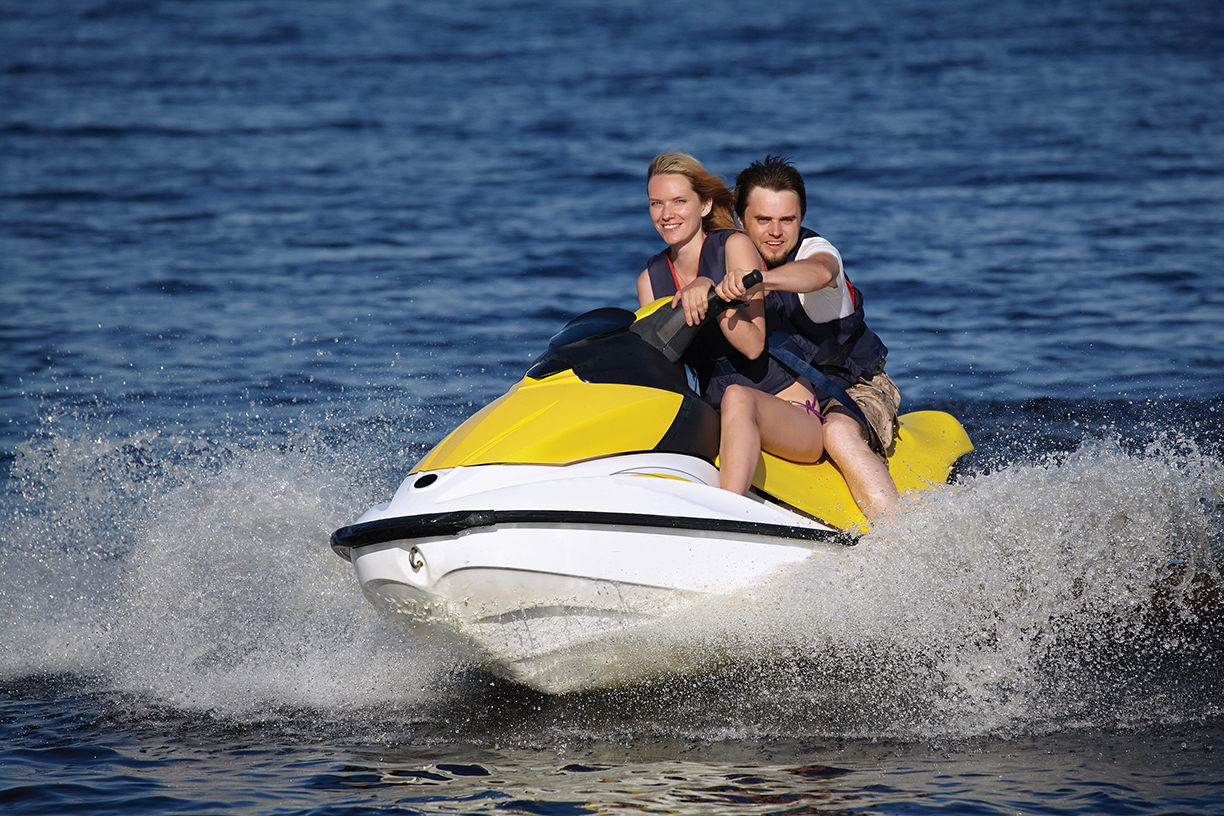
Car-free and golf cart centered communities are designed for those looking to reconnect with the outdoors and spend less time stuck in traffic.
©istockphoto.com / 300dpi
“Residents will have access to a variety of bookable spaces to allow them to expand and contract their home as needed.” A modern way of living has melded with the traditional idea of small-town communities. “Culdesac will have bookable guest suites, podcast studios, hosting spaces, and day-use office spaces to allow your home to adjust to your needs,” Sunder explains. “Why pay for a guest room 365 days a year, when you only use it a few times a month?”
Forever shifting to accommodate the residents’ needs, a car-free community like Culdesac is ideal for many people, even during these changing times amidst a pandemic. “The idea of life at your front door makes Culdesac Tempe a place that a variety of people with different needs are interested in — young professionals, students, families, remote workers, retirees, empty nesters, et cetera,” says Sunder. More spacious apartments and public workspace are functional for those residents who are working remotely, as they also don’t have to worry about commuting into an office every day. Since the pandemic, “we’ve seen increased interest from folks particularly from New York and San Francisco, and 50 percent of our waitlist are people coming from outside Arizona,” notes Sunder.
The following is a
Unique Homes Online Exclusive
During the mid-year height of the Covid-19 pandemic, real estate agents comment on how the market stood, and in some cases prevailed, under enormous pressure.
This past Fall, luxury real estate agents from across the country spoke on Unique Homes’ first Zoom panel to discuss topics from the recent article “Space: The New Currency,” from Unique Homes Magazine’s recent Fall issue, written by Camilla McLaughlin. On this exclusive virtual panel, agents were able to discuss how the real estate markets of America endured (and continue to endure) through the turbulence that the Covid-19 pandemic has caused. Throughout the discussion, these experienced panelists spoke on the changes their area(s) have undergone and the how the pandemic has affected the homebuying process. We’ve highlighted some of our distinguished panelists and their unique experiences below.

Mauricio Umansky, Founder/CEO of The Agency
Los Angeles, CA
In the beginning of “Space: The New Currency,” Mauricio Umansky, Founder and CEO of The Agency, notes that in the midst of the pandemic, consumers who were staying at home also found themselves asking impactful questions regarding their homes and their futures: where am I sequestering versus where am I at home? What do I want my home to look like? What do I want my second home to look like?
As one of the opening speakers, Umansky adds that though many of these questions may not be answered right away, the pandemic proved to be a catalyst for many potential home buyers to start a dialogue with their local real estate agents. “Sequestering at home, stay in, shelter in place, whatever it is we want to call it, has caused a conversation that is equal amongst everybody, whether it’s politically driven, whether it’s answering ‘what do I want to do with my life?’ and understanding that we can now work and operate from anywhere.”
Courtney Hampson, Vice President of Marketing
Palmetto Bluff, SC
Palmetto Bluff is a community in coastal South Carolina that caters to a mix of primary and vacation homeowners. Courtney Hampson, Vice President of Marketing for Palmetto Bluff, says on the panel that at the beginning of the pandemic many residents were already staying in Palmetto Bluff due to Spring Break, and were mandated to stay due to the shutdown. Many stayed until May when the state began opening up again, and there were several instances where those who extended their stay ended up moving to Palmetto Bluff full time. About a particular couple from New York with young children, Hampson says “They literally walked down the street into our real estate office, went on our tour, looked at available homes, closed two days later, our fastest closing ever, and that was it. ‘This is where we are,’ they said, ‘This is the plan now.'”
During the panel Hampson also stated that the utilization of virual tours and showings became more widely utilized, so much that they had to include the option on their website right away on their website.” She also noted that in the midst of everything, they found that buyers were buying almost like they were suffering from FOMO, or a Fear of Missing Out. “[Clients] are booking their stay at the hotel first, and … they have almost a fear of missing out. They’re not waiting to get here to look at real estate — they’re doing that virtually, going under contract and seeing their property the first time they come to visit.”
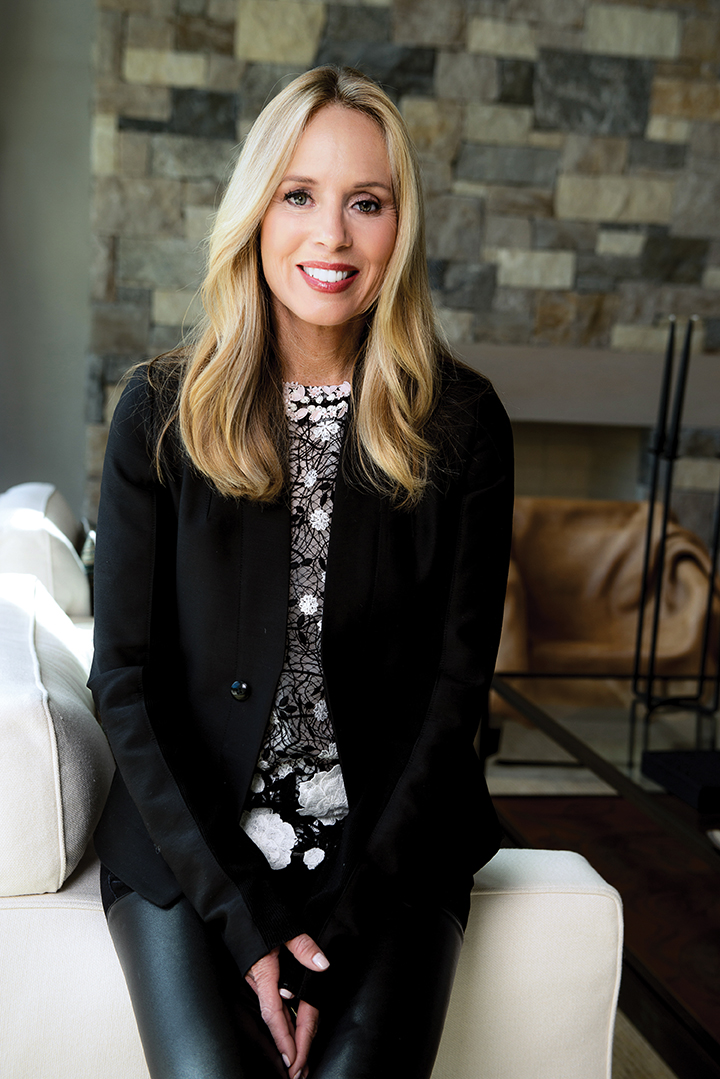
Carrie Wells, Coldwell Banker Mason Morse Real Estate
Aspen, CO
Though located on the opposite side of the United States, Carrie Wells of Coldwell Banker Mason Morse Real Estate in Aspen, Colorado experienced similar situations as Hampson had in South Carolina. March is typically the latter part of the state’s skiing season, but due to the pandemic the season was cut short, and those visiting found themselves sequestering in Aspen — and staying. She remarked that you can see this reflected in the school district alone, where 175 new students were admitted and a weight list was created for the Aspen Country Day School, Aspen’s main private school. She also noted that with the help of Matterport virtual tour technology many sales were able to happen, as clients wanted to be able to visit openings safely.
Wells remarked about her own experience with a New York family who stayed in Aspen until the summer. “He said, ‘I never realized that Aspen is so enjoyable in April and May,’ which are normally our off-season months. … People have experienced being here year-round, when they normally would not be here, and there’s so much to do other than downhill skiing that I think regardless of what happens with our winter, we’re still going to see our market continue to be strong.”
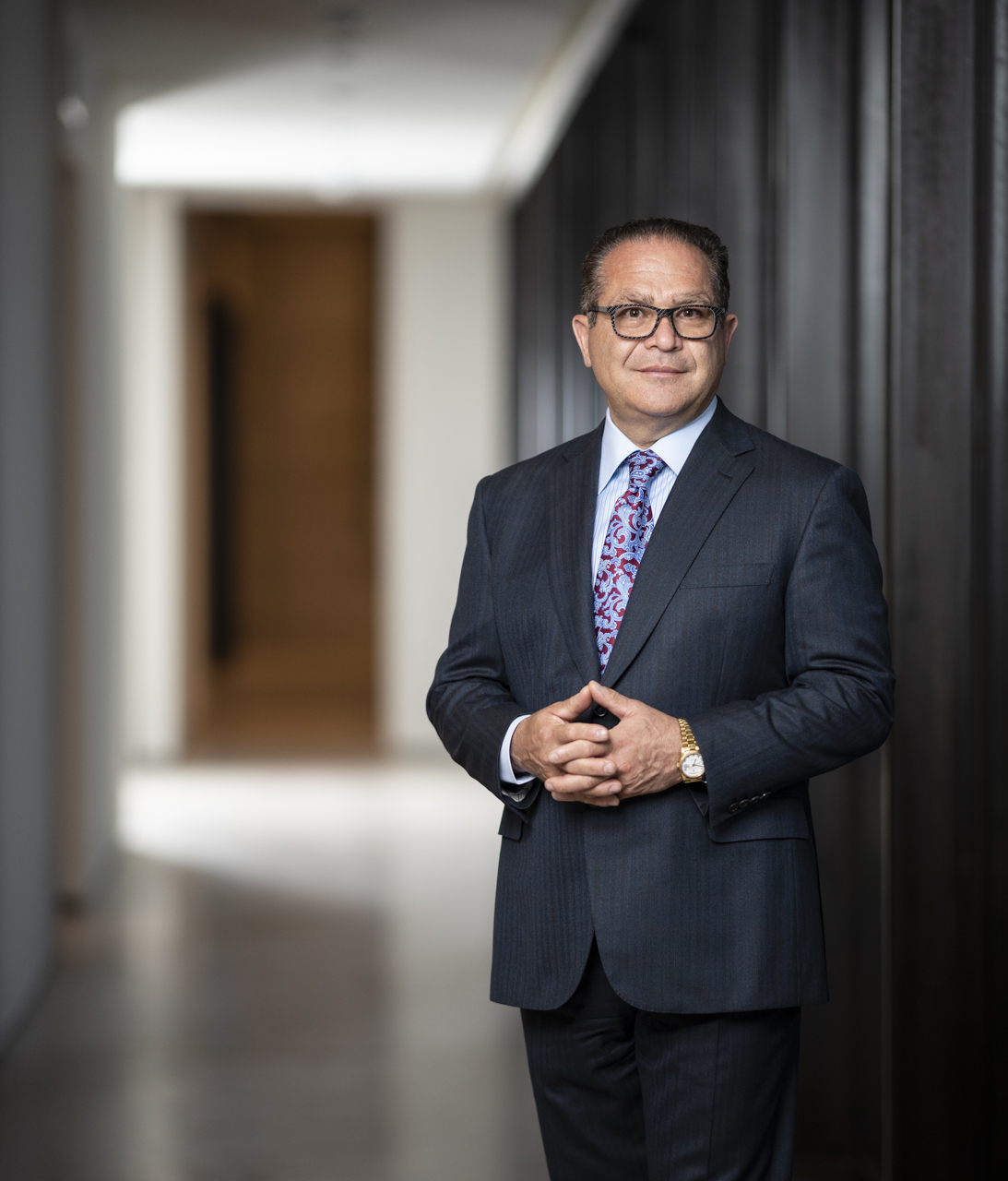
Frank Aazami
Russ Lyon Sotheby’s International Realty
Scottsdale, AZ
The title of the article “Space: The New Currency,” as well as the main point of discussion for the panel, was inspired by profound statement by Frank Aazami of Russ Lyon Sothebby’s International Realty. During the panel Aazami notes that when the pandemic began and people were sequestering, he noticed that areas that were previously difficult to sell beforehand, regions outside of Phoenix and Scottsdale such as Fountains Hills, Cave Creek, etc, were now like beacons that buyers were gravitating towards. Before there were no sales north of $3 million, but eventually there were closings reaching upwards of $4 and $6 million. The reasoning for this market change? Space!
In the article Aazami notes that from his region of Scottsdale, Arizona, his experience during the pandemic that no matter what buyers were generally looking for, a vacation home, relocation refuge, etc., the key point he saw was that consumers were looking for a safe haven, with plenty of space. Not only that, but consumers are also requesting specifics when it comes to this space in order to make their purchases personal and customized to their lifestyles, from multiple offices and indoor gyms to view decks and larger patios.

Chris Bernier, Churchill Properties
Boston’s North Shore, MA
Located just 30 minutes outside of Boston, Chris Bernier of Churchill Properties notes during the Zoom panel that despite the usual trends of buyers looking for smaller, more minimalistic style homes, space really is the new currency. He affirms that many buyers in his market are flocking toward the larger homes. These market shifts are no doubt due to the pandemic shifting priorities, and continues to show
James Torrance, Keller Williams Luxury International
Palm Beach, FL
James Torrance from Palm Beach, Florida has much to say about the pandemic has shifted Florida into more than just a retirement or snowbird refuge, seen in these clips from the Zoom discussion. He notes further that in fact a large wave of buyers from California and more specifically Chicago brought interest to the area and helped close several sales, a rarity in his area. What was also interesting that he notices are the importance of the private schools and districts in South Florida, as he mentions that many buyers were shopping around different homes once they had found a school system they liked, then picking from available homes nearby.
This, alongside his points about the importance of homes with multi-functional spaces such as guesthouses and just the overall outlook on how the market has shifted, highlight just how much action Florida has seen in the past several months due to Covid-19’s effect on real estate.
Roxann Taylor, Engel & Völkers Dallas Forth Worth
Dallas, TX
As an real estate agent with 40-plus years of selling experience, Roxann Taylor of Engel & Völkers Dallas Forth Worth was a fountain of wisdom toward the end of the virtual panel. She highlighted much of which was similar to what the other panelists had noted, including buyers prioritizing homes with large space as opposed to downsizing, putting houses on the market through a near fully-virtual process, and much more.
For More Unique Homes Online Exclusive content, click here.

Those who know us have seen that the Private Client Group brand at Russ Lyon Sotheby’s International Realty has a passion for offering first-class service coupled with top-tier print to web marketing exposure of our listings.
Your trust and commitment to working with us has given us a ranking as the No. 1 Sotheby’s International Realty team in Arizona — and No. 9 team worldwide in 2018. Our properties have historically sold at the highest values within the shortest time. Our successes have also set us apart by conversing with and serving collectors and trendsetters who are connoisseurs of Sotheby’s International Realty fine living lifestyle from around the globe.

Our ability to elaborate on topics that matter most to our clientele has truly defined who our members are: We like to say they are veterans of making dreams come true. Our exclusive partnership with media giants has also helped us assemble the content within this issue that we hope you’ll enjoy. These efforts have garnered savvy and refined international buyers for our properties.
We achieved our reputation by affiliations—best practices and best strategies to sell a home—not just to “list a home,” but to sell a home not merely by “showing it.” The Private Client Group expansion and footprint in over 75 international luxury markets will promote and unite the best sales our market can earn. Earlier this year, we set the record for selling the highest residential sale ever recorded on the Arizona Regional MLS.
When you’re ensconced in that unique experience of a property, particularly one that has been the labor of passion or love, the home almost becomes a window to the soul. To have the opportunity in understanding the life journey within a home is exactly why it’s so easy for us to become passionate about real estate.
The Private Client Group is ready to make your real estate journey a memorable experience… all by design, not by luck. We very much look forward to personalizing our extensive services for you.

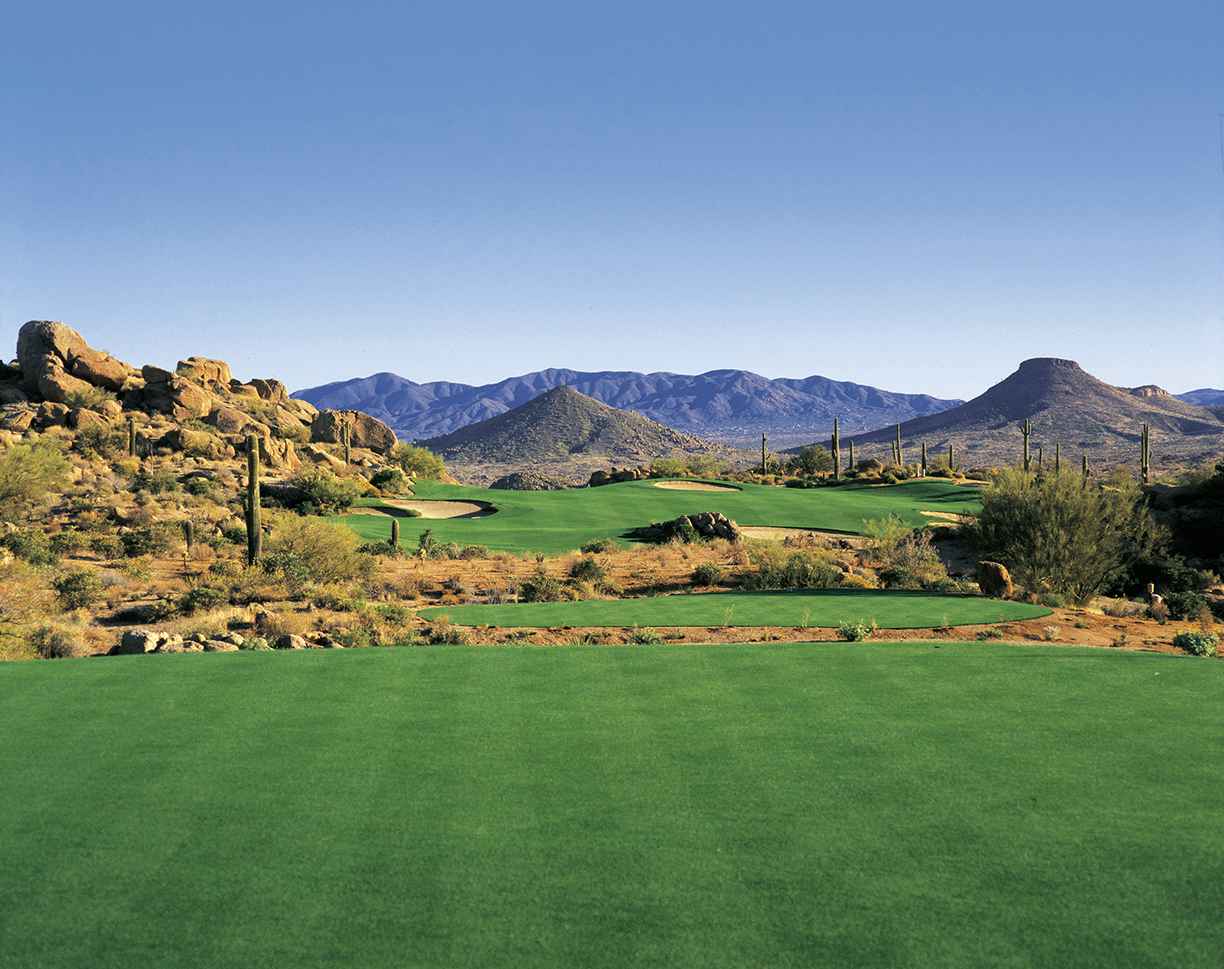
Photo courtesy of Troon North Golf Club
With art museums, golf courses and luxury architecture, Scottsdale, Arizona is more than just a desert town.
Known as The West’s Most Western Town, Scottsdale, Arizona, is certainly more than just a desert town as it is annually rated among the nation’s most desirable communities to live in, visit and conduct business. Three focuses in particular are art, golf and architecture, each a key draw for the luxury sector and ones that have shaped the culture of the city.
Among Scottsdale’s 80 art galleries are museums that not only showcase fantastic creations from artists, but also provide an insight to the city’s past. One in particular is Western Spirit: Scottsdale’s Museum of the West, located in Old Town, which offers high-quality exhibitions reflecting the arts and dynamic cultural exchanges in the city’s history. Dr. Tricia Loscher, assistant director of collections, exhibitions and research at Western Spirit, says that the Scottsdale art scene started at the Arizona Craftsmen Center in the 1940s, where skilled artisans could work and collaborate together, and customers could watch art being created in front of their eyes. These artists in turn helped to elevate Scottsdale’s cultural standing by showing and selling their unique creations.
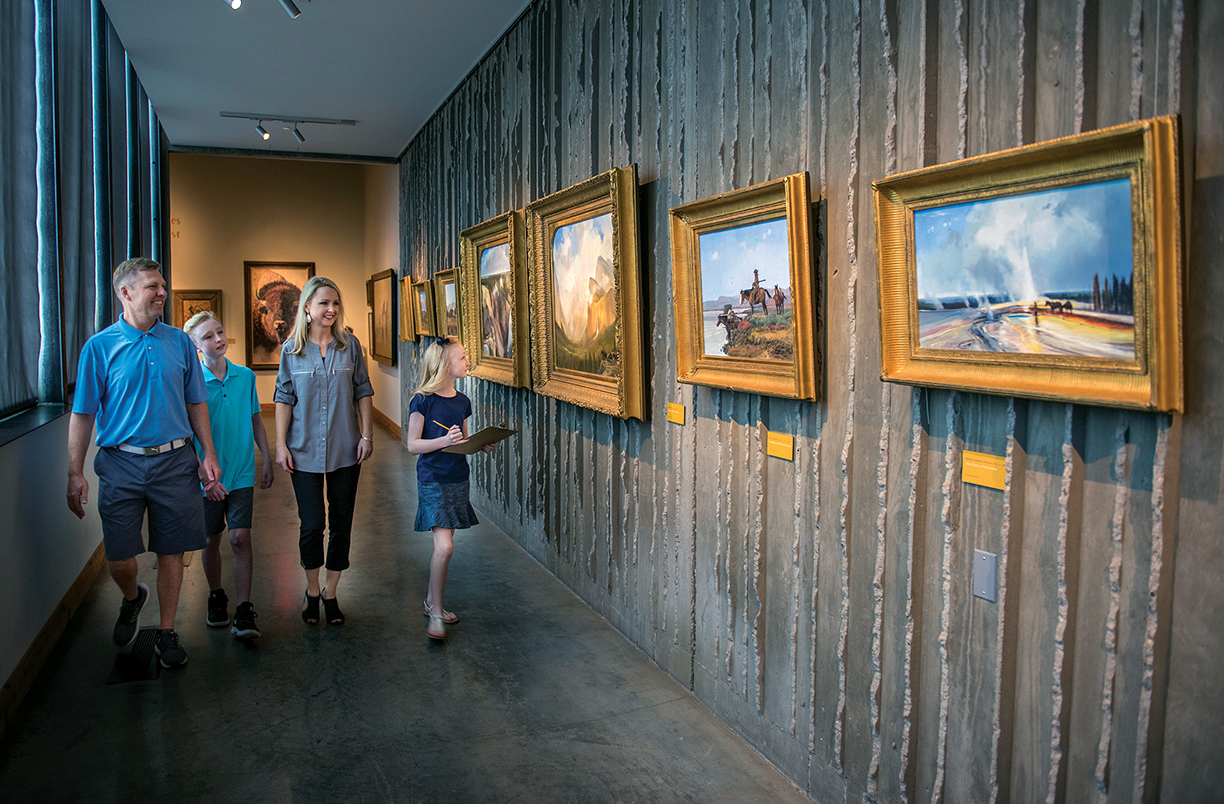
Photo courtesy of © Loren Anderson 2018
Museum of the West
Today, artists are continually drawn to Scottsdale, a place that is recognized worldwide as a destination for art collectors and enthusiasts. The diversity of the city’s artistic community, says Loscher, leaves visitors remarking on how much there is to see, and that it cannot all be viewed in one trip. “You’ll want to come back again and again because you can’t possibly do justice to what Scottsdale has to offer.”
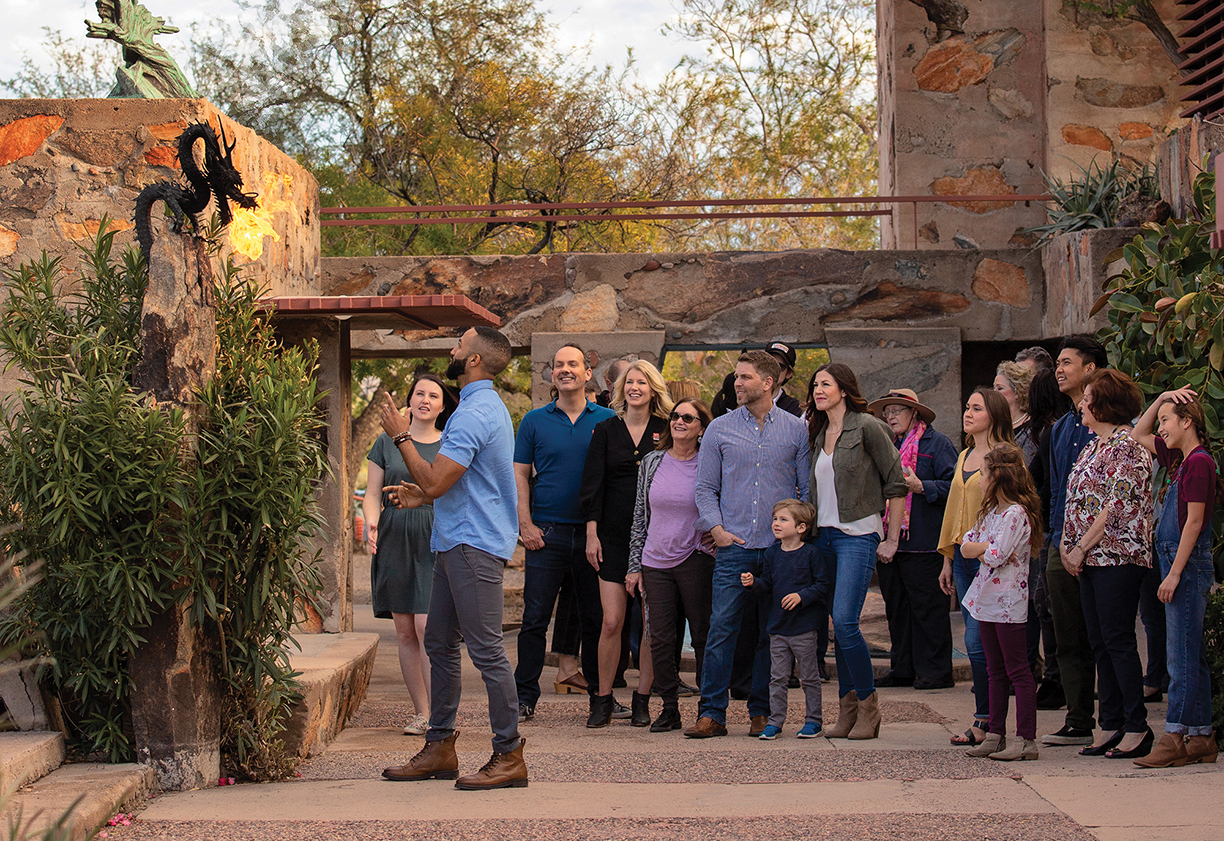
Photo courtesy of © Jill Richards Photography
Taliesin West
The distinctive landscape of Arizona, punctuated by giant granite boulders strewn across the rugged Sonoran Desert, is the perfect playground for those who live and breathe the golf lifestyle. There are several key points as to why Scottsdale is such a popular golf destination, according to Mike Friend, director of sales at Troon North Golf Club, from wonderful weather to the beautiful desert itself. “The unique desert layouts are so different from typical tree-lined golf [courses],” he notes, adding that players love how the green grass contrasts from the desert browns.
This culture began in the 1990s as many courses over the last 30 years were built around luxury residential developments and communities, which also stimulated the growth of resorts and travel interest overall. “The growth of this type of traveler created a need for more golf,” Friend says. The travel fever has not stopped since, and from the variety of activities and sights, Scottsdale is bound to experience growth and diversity for years to come.
Also nestled in the desert, along the foothills of the McDowell Mountains, is an architectural mecca — Taliesin West, known to historians as Frank Lloyd Wright’s desert laboratory in Arizona. Taliesin West was Wright’s beloved winter home and the headquarters of the Taliesin Fellowship, an architectural marvel that has since become a National Historic Landmark, as well as the home of the Frank Lloyd Wright Foundation and the School of Architecture at Taliesin.
“[Wright] found the site in 1937 and with his apprentices began experimenting with new materials and building techniques to create a desert camp that embodied his principles of organic architecture,” according to Foundation president and CEO Stuart Graff. The Foundation works to preserve the site and Wright’s legacy through programs that bring more than 110,000 visitors to Scottsdale. Here Wright’s experimental camp is open to the world as a living expression of his ideal vision for how he wanted humanity to live in harmony with the world around us.
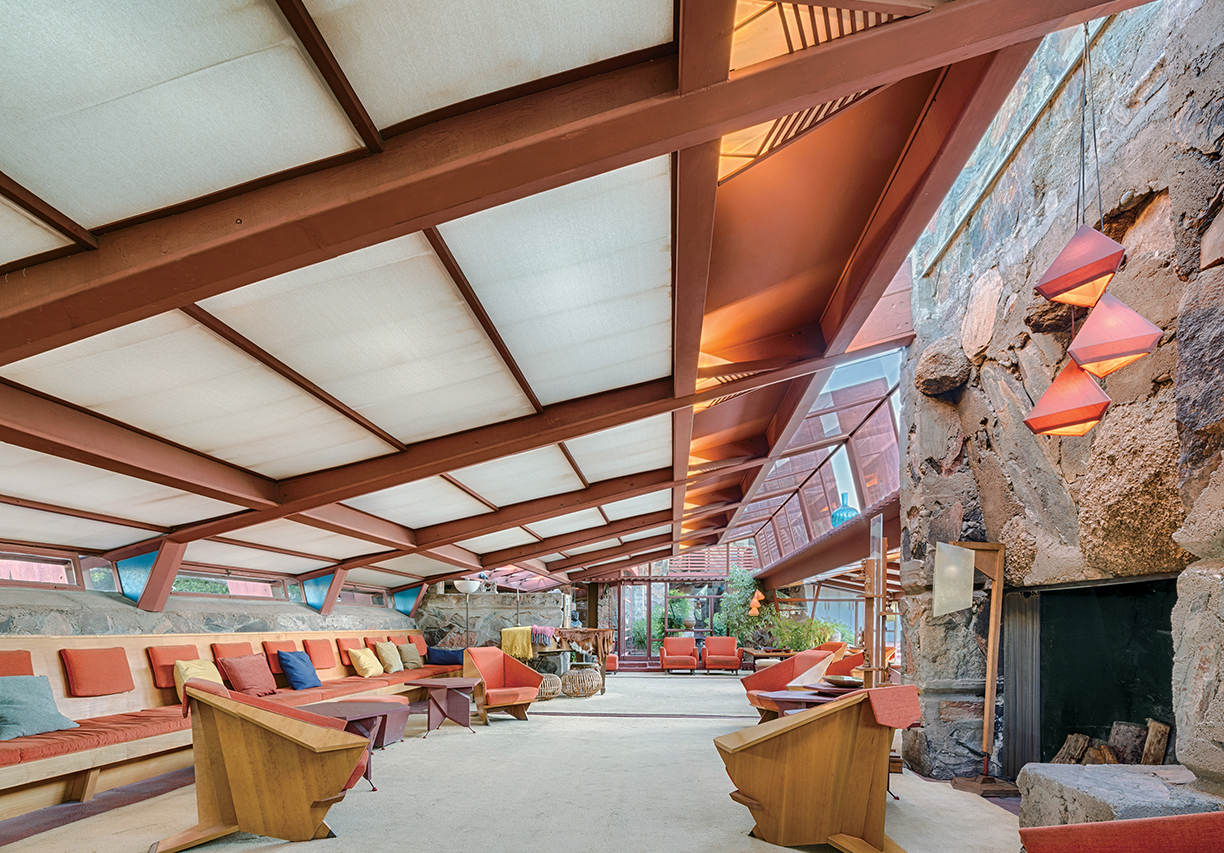
Photo courtesy of © 2016 Andrew Pielage
Taliesin West
This editorial originally appeared in Unique Homes Winter 2020.
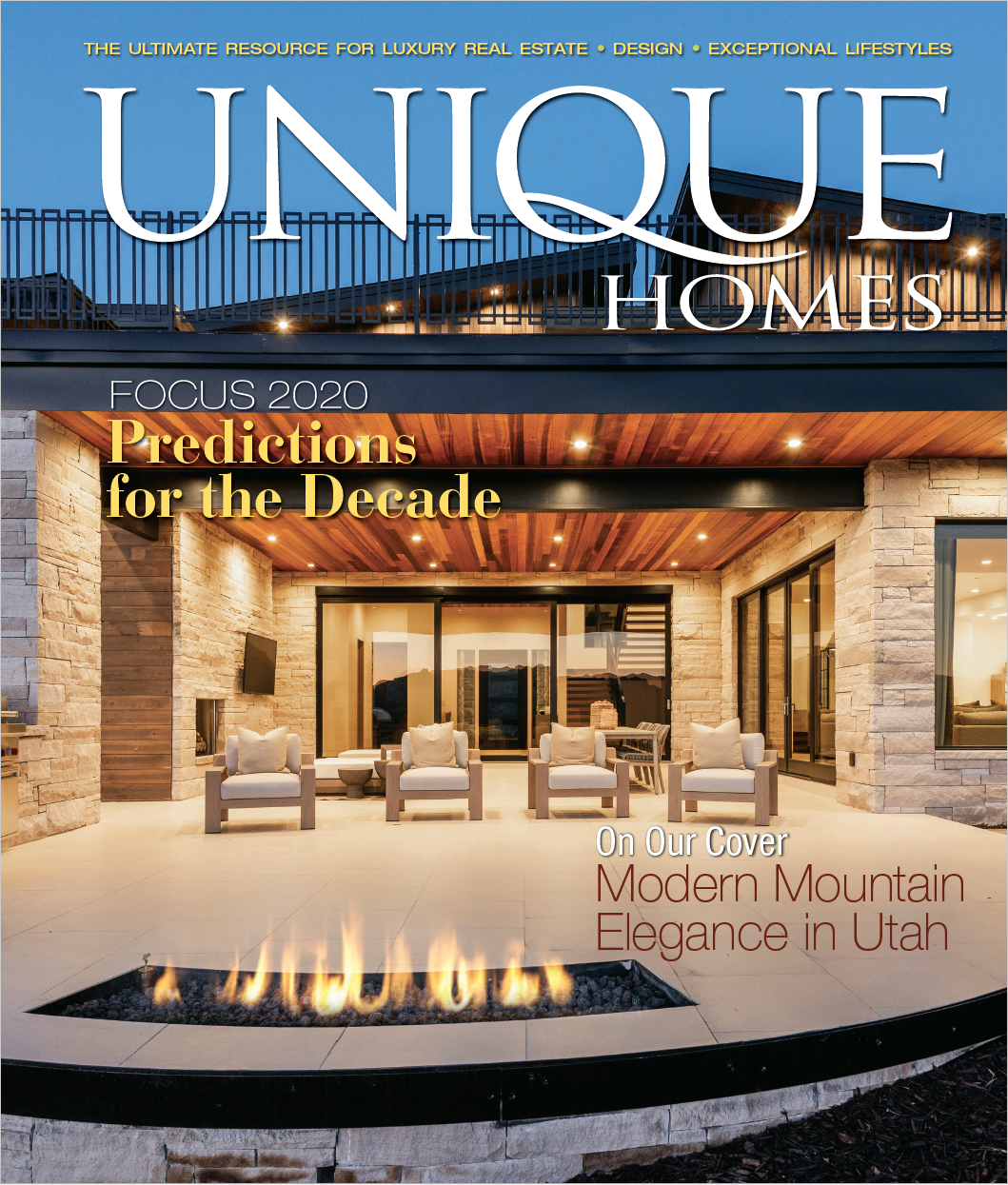
These U.S. West Coast resorts are lauded for their outstanding views, stellar dining options, and luxurious vacation packages and amenities.
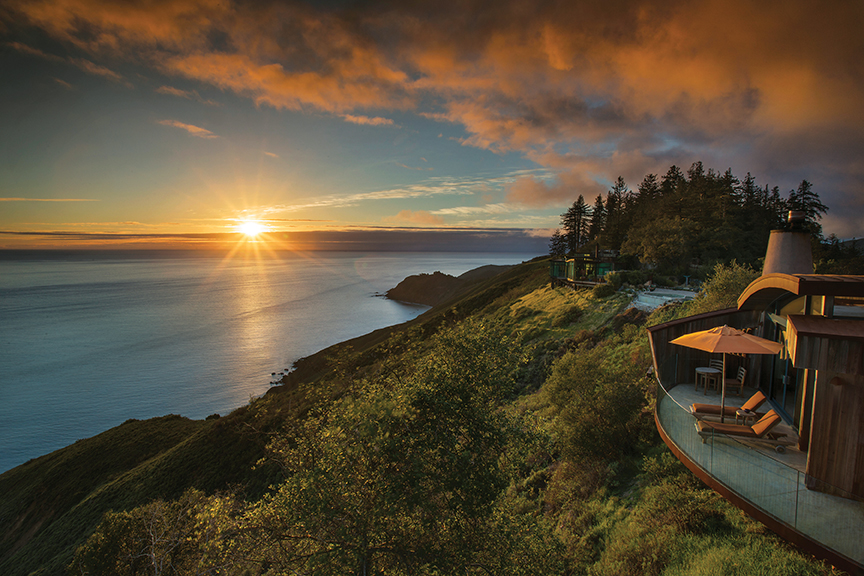
POST RANCH INN, BIG SUR, CALIFORNIA
A serene retreat along the California coastline, the Post Ranch Inn offers both beautiful ocean and mountain views. None of the rooms include televisions or alarm clocks, so a vacation here really is one for relaxation and retreat. Available to all guests are nature walks, stargazing, infinity pool spas, and spa packages.
Courtesy of Kodiak Greenwood
THE RITZ-CARLTON, HALF MOON BAY, CALIFORNIA
Escape the hustle of San Francisco and Silicon Valley and retreat to this resort, just 30 minutes from both. The Ritz-Carlton offers secluded cliff-top views of the Pacific and an opportunity to enjoy the California woods. With a luxury spa, tennis and other amenities, this resort proves Half Moon Bay is not to be overlooked.
Photo by Veronica Werhane
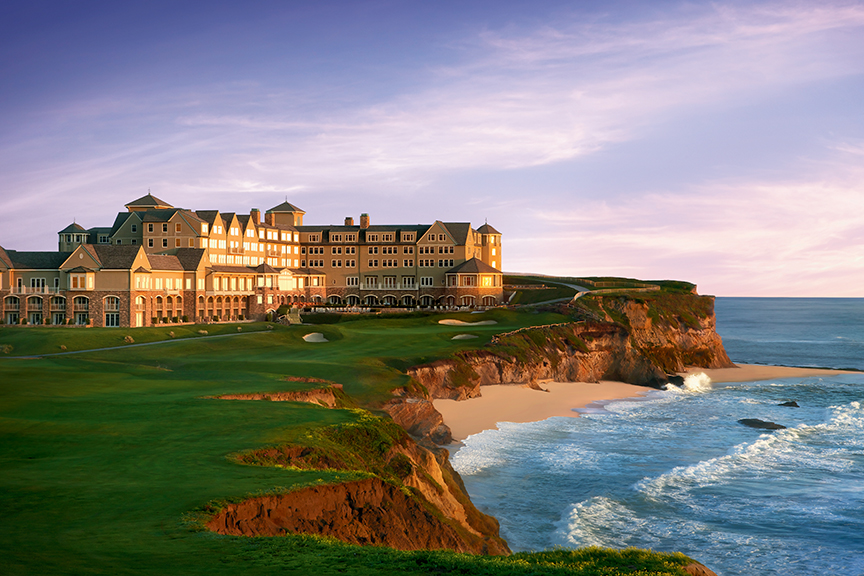
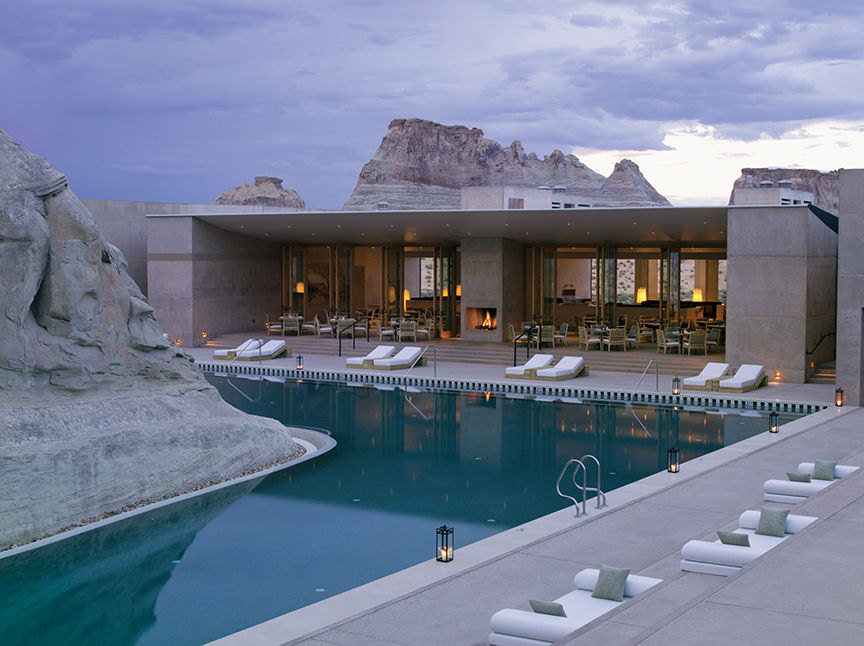
AMANGIRI, UTAH
The 5-star Amangiri is smack in the middle of the Colorado Plateau, offering unbeatable views of Canyon Point, Utah’s geological masterpieces. With an emphasis on wellness, this resort will rejuvenate guests with opportunities for hiking, climbing, and relaxing at the spa. Explore the canyons by hot air balloon or kayak Lake Powell; the expeditions are endless.
Courtesy of Aman
BOULDERS RESORT AND SPA, ARIZONA
Travel + Leisure voted Boulders Resort and Spa the Best Hotel in Arizona, and with good reason. For the most luxurious and private getaway this resort has to offer, choose the Villa Retreat. This package includes two expansive villas, complete with a private infinity pool, Japanese soaking tub, barbecue pit and kitchens, and large master bedroom overlooking massive rock formations.
Courtesy of Boulders Resort and Spa
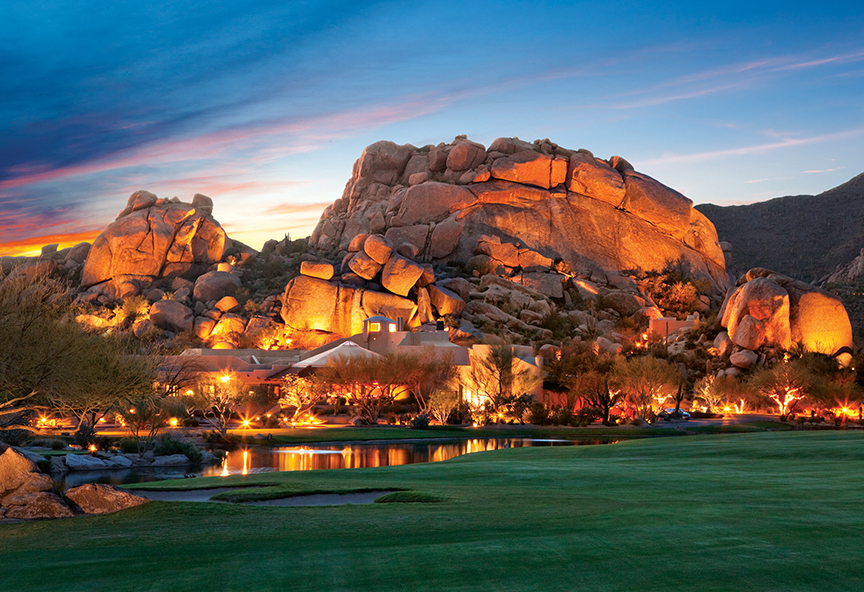
They’re going fast! Mountain Shadows’ new resort condominiums and suites are flying quickly off the market, with only 13 of the 42 units remaining. These brand-new condos in the luxury wing of Mountain Shadows in Paradise Valley, Arizona mark the completion of the $100 million new-build resort in March 2018.
Sitting at the foot of Camelback Mountain, Mountain Shadows Resort Condominiums is the first three-story resort residential building in Paradise Valley, designed for those seeking “lock and leave” resort-style living. Direct access to the entire Mountain Shadows resort encourages owners to take advantage of incredible amenities and resort perks, such as housekeeping, valet and concierge services, access to the wellness-centric Citizens Club and juice bar, and access the only 18-hole, par-3 golf course in Arizona. The Mountain Shadows Resort Condominiums offers studio, one-, two- and three-bedroom floor plans, ranging from 1,000 to 3,410 square feet and priced from $840,000 to $4.1 million.
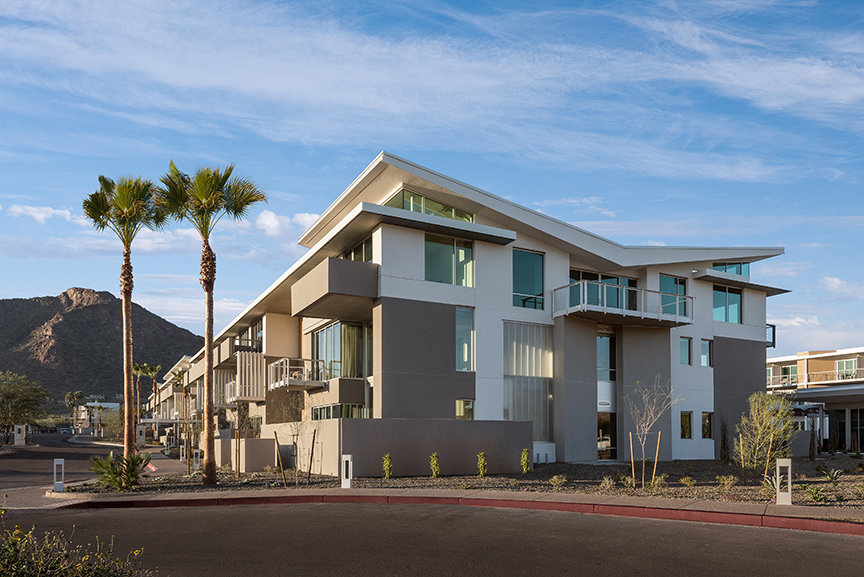
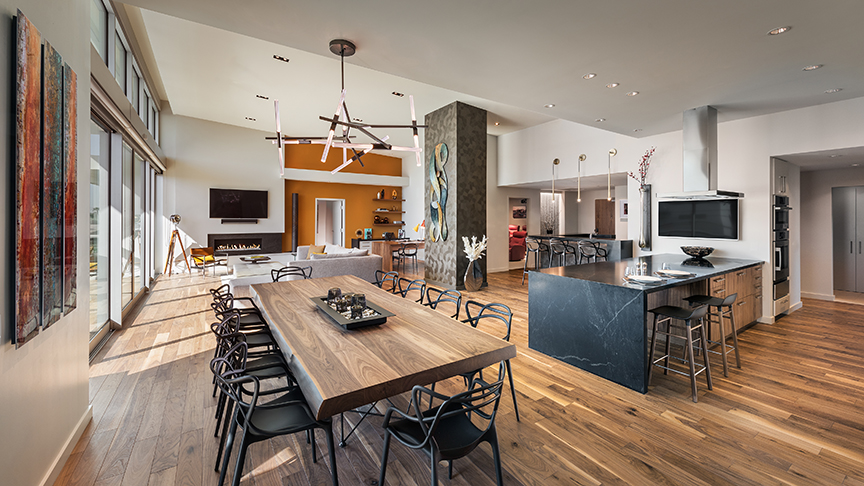
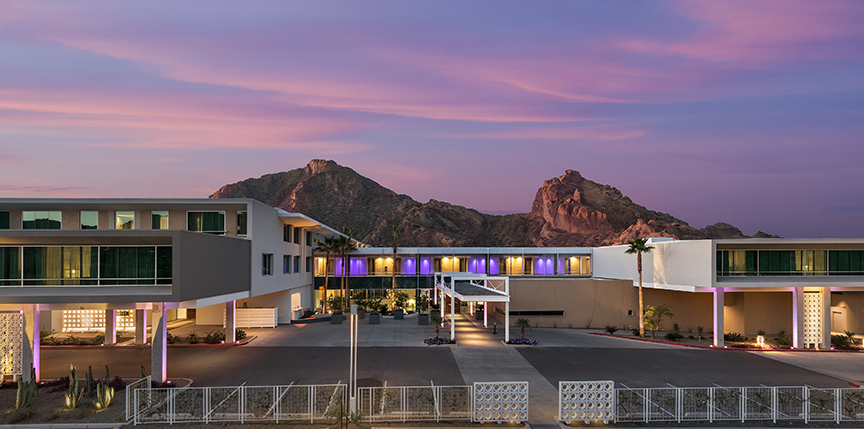
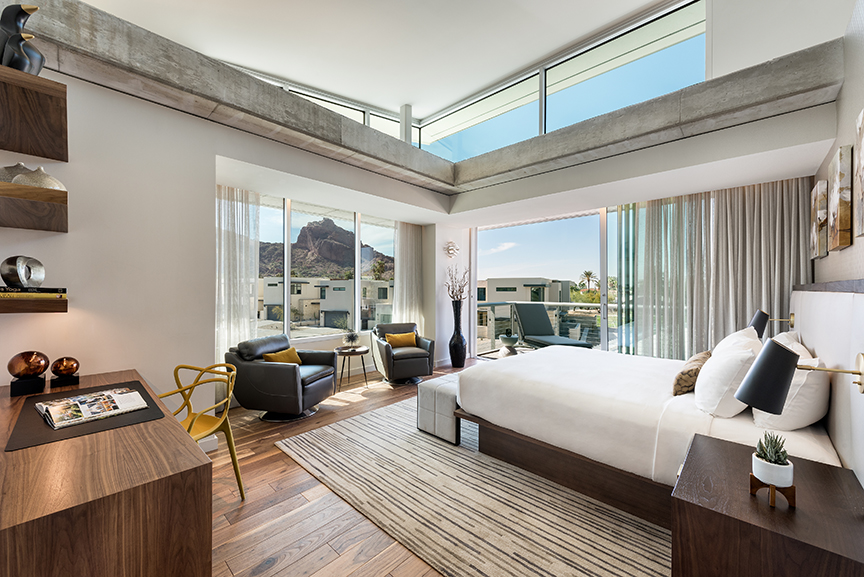
Designed by Scottsdale-based Allen + Philp Architects, each condo and suite at Mountain Shadows Resort Condominiums is a personal retreat for residents to rest among the best of mid-century modernism and contemporary design.
An icon of the desert, Mountain Shadows is an upscale boutique resort, with its roots in 1950’s modernism. The original property closed in 2004, replaced by a $100 million new-build resort by acclaimed developers of Sanctuary on Camelback Mountain Resort & Spa and Hotel Valley in April 2017. A brand new fitness center and outdoor pool unveiled during the opening, called The Citizens Club, a high-tech fitness center offering an array of 60-minute classes, and two 75-foot pools, connected by a modern waterfall feature and dramatic views of Camelback Mountain and the surrounding desert beauty.
Photos courtesy of Mountain Shadows
guests at tanque verde ranch can adventure through miles of horseback riding trails that go deep into the rincon mountains and Sonoran desert.
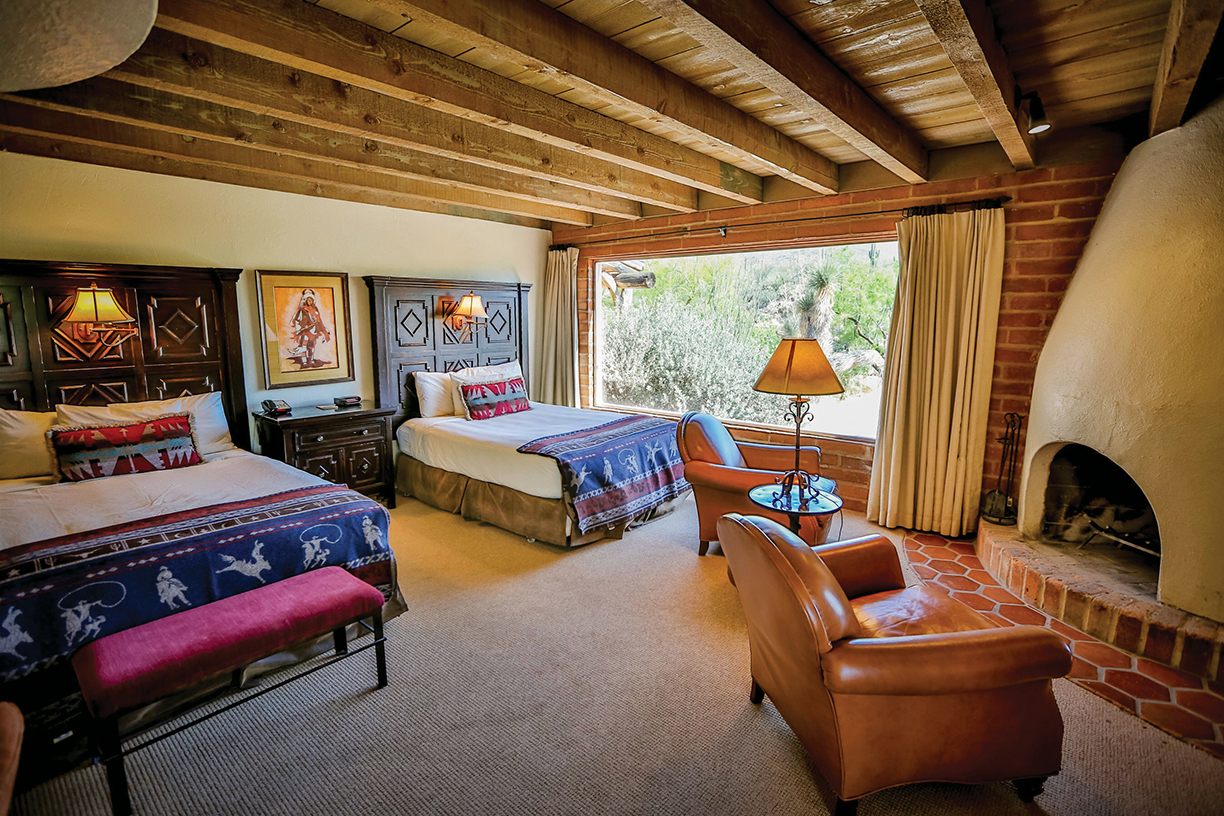
Seated in the sweeping mountain ranges and boundless desert of Tucson, Arizona, Tanque Verde Ranch combines the spirit of the Old West with today’s modern amenities.
“We’re right at the base of the Rincon Mountains, and the sunsets here are like no other,” says Terry Hanley, the general manager of Tanque Verde Ranch.
Spectacular scenic views can be witnessed in one of the various lodging options, which are tastefully decorated in a traditional southwestern theme with adobe walls and Santa Fe-style architecture.
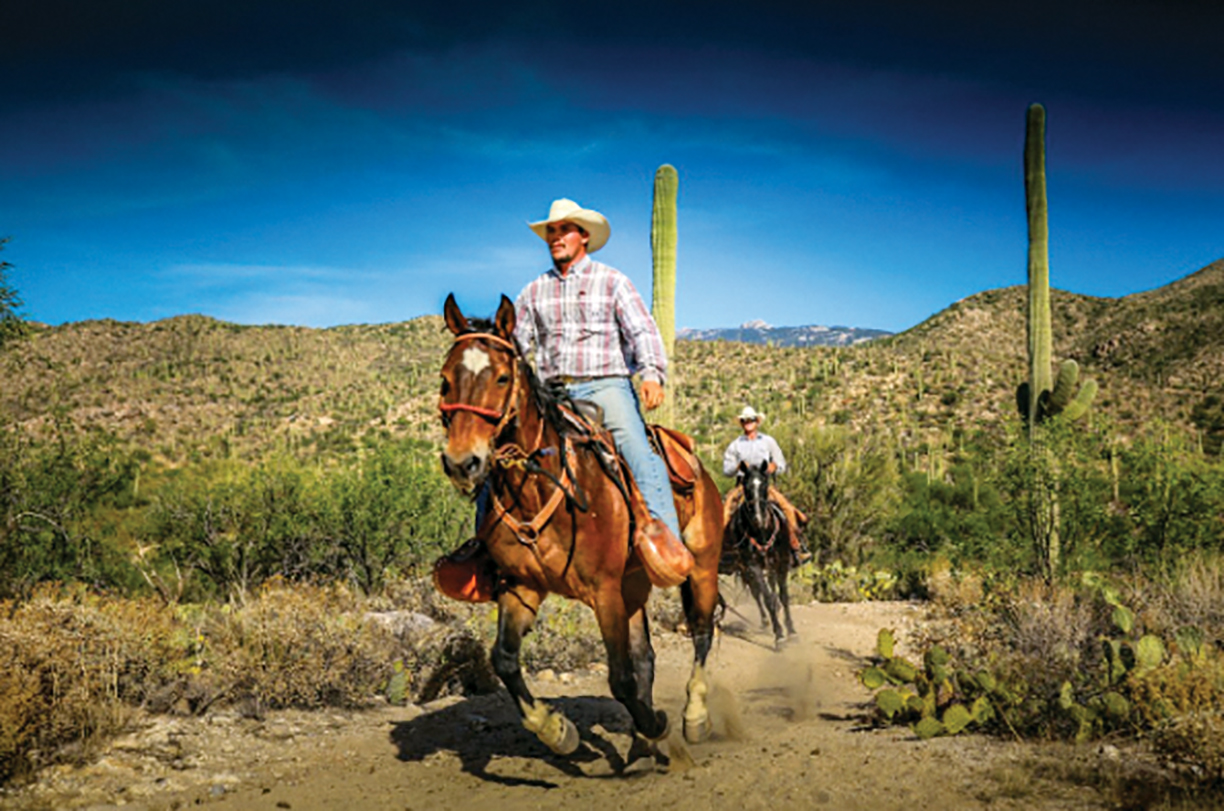
Celebrating its 150th anniversary, Hanley recalled how Tanque Verde Ranch started as a cattle ranch in the ’20s and was eventually turned into a horse ranch. With more than 150 horses provided by the ranch, guests can take horseback riding lessons or adventure through miles of horseback riding trails.
Every Sunday and Thursday morning, guests can go on an unforgettable trail ride passed towering cacti and rolling hills to the Old Homestead where freshly prepared breakfast is served.
“We are famous for our blueberry pancakes,” Hanley says.
This ultimate dude ranch experience provides a wide range of activities such as fishing, swimming, mountain biking and hiking. The ranch also has outdoor cookouts, country music entertainment and coordinated activities such as chili cook-offs.
— Brielle Bryan
Photos courtesy of Tanque Verde Ranch
Real estate professional Jennie Heal puts her skills as an auctioneer to work for good causes.
By Roger Grody
Supreme Auctions provides an alternative marketing strategy for sellers of luxury real estate. The Scottsdale, Arizona-based firm’s President, Jennie Heal, explains, “We saw an opportunity to provide owners the ability to sell their property in a more expedited manner and many times for far more money than traditional real estate can bring.” She reports the process has been embraced by sellers, listing agents and buyers.
Since its founding 15 years ago, Supreme Auctions has achieved a 94-percent success rate while selling in 70 different countries. “We’re very selective about the properties we auction, accepting only about 10 percent that come to us,” says Heal, a veteran broker with extensive experience in international marketing. She joined the company more than 12 years ago as director of marketing before ascending to the position of president. The auction process is familiar to Heal, as this is a prevailing means of selling luxury manors and estates in her native England.
Growing up in rural Somerset, Heal frequently attended auctions with her father, a farmer who enjoyed bidding on cattle and antiques. “I was bitten by the bug at an early age, but remember him saying, ‘Keep your hands in your pocket,’” says Heal of those childhood experiences. Even after joining a real estate auction company, the seasoned professional’s development as an actual auctioneer occurred very much by accident.
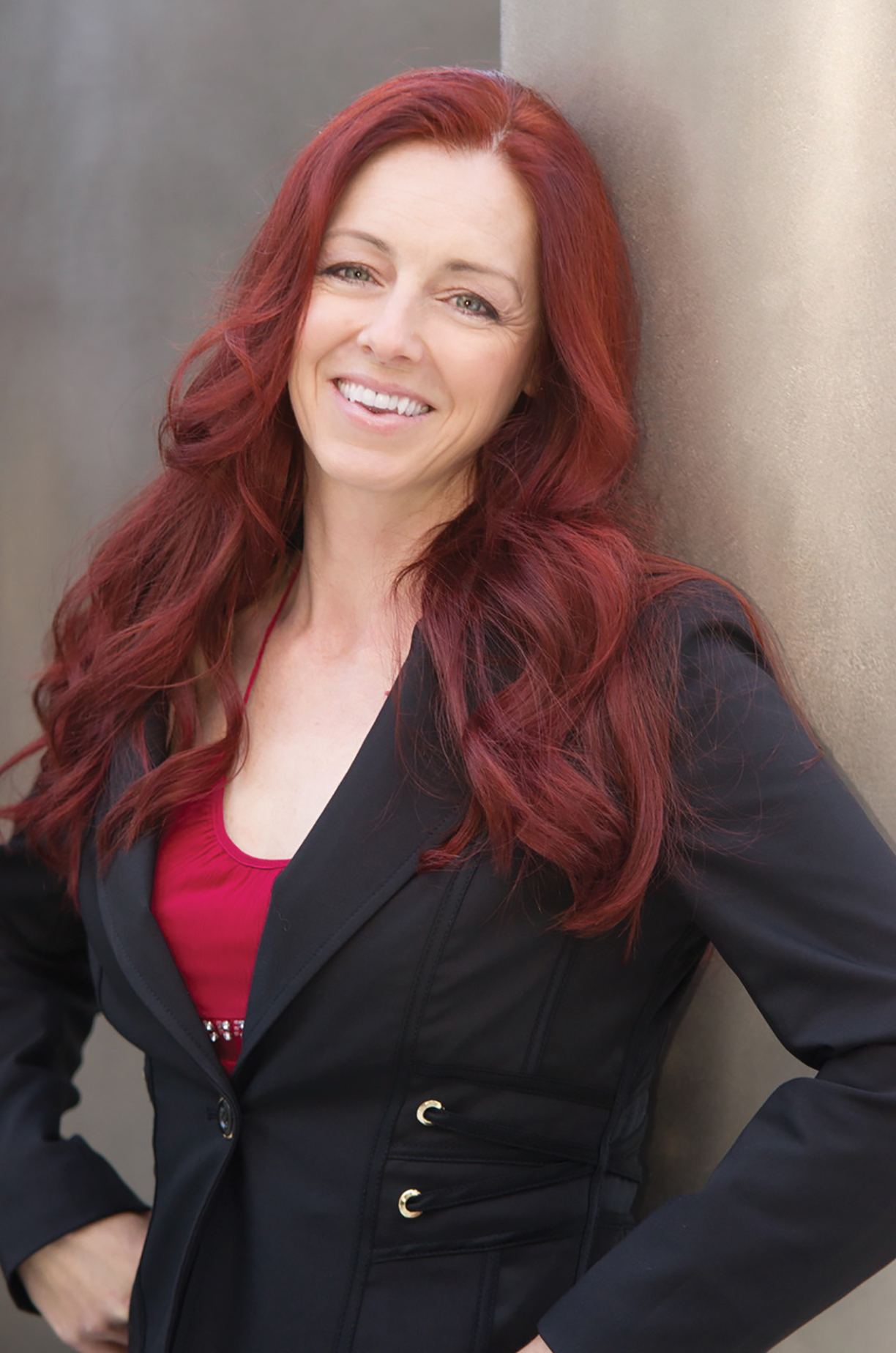
“I was attending an event to raise money for my son’s school, and the auctioneer never showed up,” recounts Heal. “One of the parents said, ‘You work for an auction company … why don’t you do it?’ and I found myself on stage.” After her reluctant debut, another parent commented, “You’re really good at this!” When she decided to get serious about auctioneering, Heal attended the Texas Auction Academy and additionally the Professional Ringmen’s Institute.
Heal now serves as a charity benefit auctioneer at approximately 50 events per year, but spends a considerable amount of time before each auction with representatives of the nonprofit organization. “I want to thoroughly understand their missions so I can be as effective as possible in raising money for them,” says Heal, who views herself equal parts salesperson and auctioneer. “I see myself as a conduit from the nonprofit to the audience and frequently conduct additional pledge donations at the conclusion of the live auction,” she explains.
“I was attending an event to raise money for my son’s school, and the auctioneer never showed up,” recounts Heal. “One of the parents said, ‘You work for an auction company … why don’t you do it?’ and I found myself on stage.”
Bringing the spirit of Sotheby’s or Christie’s to those nonprofit galas, Heal’s work has benefitted a diverse array of charities, including Ronald McDonald House Charities, YWCA, Phoenix Zoo, Arizona Foundation for Women, and St. Jude Children’s Research Hospital. Legendary for covering all costs of a child’s care, as well as the family’s travel, housing and food expenses, St. Jude is a particularly personal passion of Heal’s, whose brother is a brain tumor survivor. The non-profit has selected her to conduct auctions across the country and Heal never declines an opportunity to raise money for its world-class treatment and research.
Back at her day job with Supreme Auctions, Heal is creating a culture in which giving back to the community is strongly encouraged.
Last year, she and her staff participated as a team, cleaning facilities for Family Promise, an organization that rescues homeless families from the streets. This year, they are planning to work together on a Habitat for Humanity house.
Heal, who lives in Scottsdale with her husband and two children, loves the outdoors. “Any day I am not sat behind a desk is a great day,” she quips.
State capitals are oftentimes thriving cities with a lot of economic and cultural value. In fact, they can be some of the best places to live in America. But not all state capitals are created equal. WalletHub has put together a list of 2018’s Best State Capitals to live in. And though 17 of them are the largest cities in their states, the biggest population doesn’t always represent the best quality of life.
In order to determine which state capitals make the best homes, WalletHub compared all 50 across 51 key indicators of affordability, economic strength, quality of education and health, and overall living standards. Our data set ranges from cost of living to K–12 school-system quality to number of attractions.
Best State Capitals to Live In
- Austin, TX
- Madison, WI
- Boise, ID
- Lincoln, NE
- Bismarck, ND
- Raleigh, NC
- Denver, CO
- Salt Lake City, UT
- Juneau, AK
- Concord, NH
- Columbus, OH
- Helena, MT
- Olympia, WA
- Oklahoma City, OK
- St. Paul, MN
- Cheyenne, WY
- Montpelier, VT
- Pierre, SD
- Des Moines, IA
- Phoenix, AZ
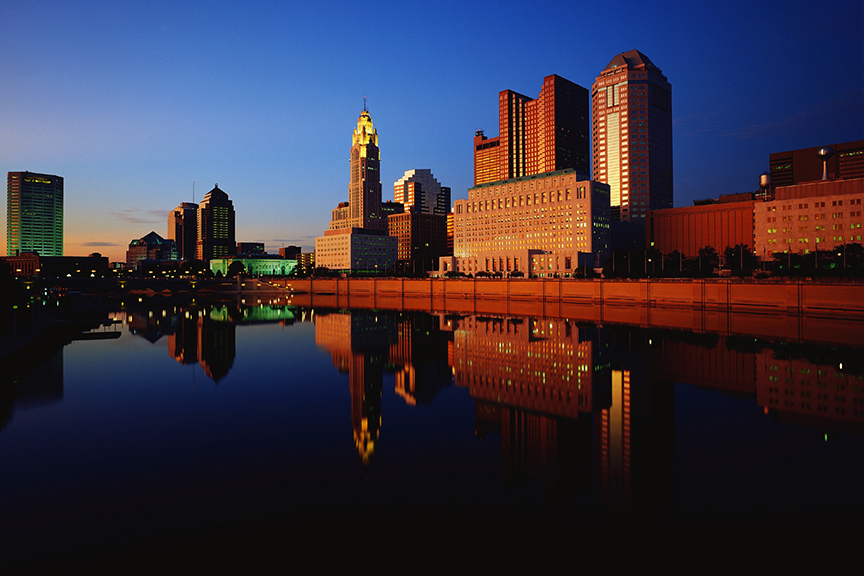
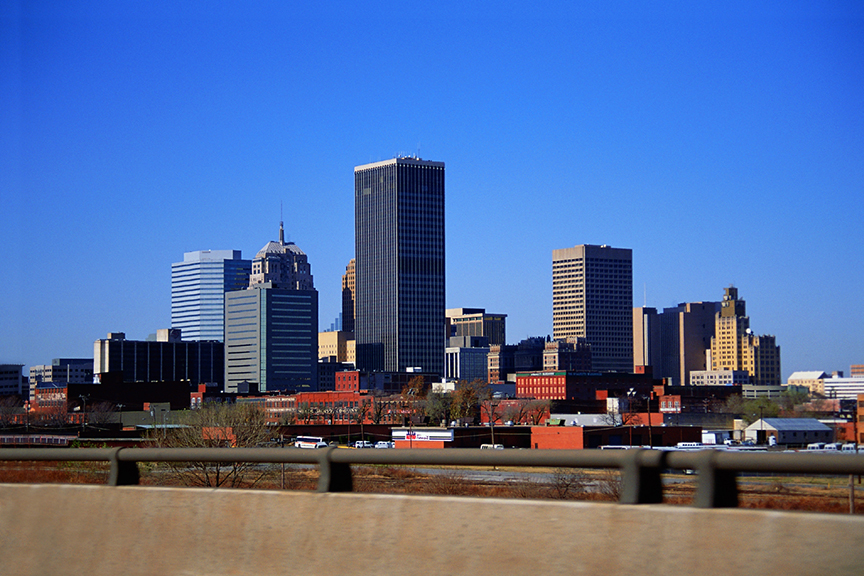
Pictured above: Columbus, OH waterfront; Oklahoma City, OK
Out of these places:
- Juneau, Alaska, has the highest median household income (adjusted for cost of living), $67,310, which is 2.6 times higher than in Hartford, Connecticut, the city with the lowest at $26,264.
- Bismarck, North Dakota, has the lowest unemployment rate, 1.7 percent, which is 4.6 times lower than in Hartford, Connecticut, the city with the highest at 7.8 percent.
- Providence, Rhode Island, has the lowest share of state-, local- and federal-government employees, 8.4 percent, which is 4.6 times lower than in Juneau, Alaska, the city with the highest at 38.4 percent.
- Madison, Wisconsin has the highest share of adults 25 years and older with at least a bachelor’s degree, 56.3 percent, which is 4.7 times higher than in Trenton, New Jersey, the city with the lowest at 11.9 percent.
For the full story, and the entire list of best small cities, visit WalletHub.com.

Phoneix, AZ

Denver, CO


